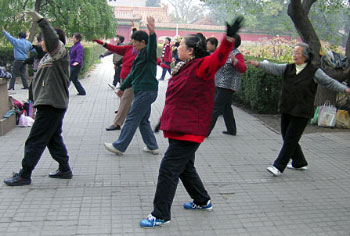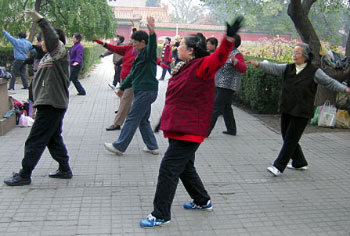Qi Gong – Introduction
Qigong is an increasingly popular aspect of Chinese medicine. Qigong is mostly taught for health maintenance purposes, but there are also some who teach it, especially in China, for therapeutic interventions. Various forms of traditional qigong are also widely taught in conjunction with Chinese martial arts. There are many hundreds, if not thousands, of different styles and schools of qigong. In general, qigong schools teach their own variations of physical training routines based on coordinating different patterns of breathing with different physical motions of the body. Qigong relies on the traditional Chinese belief that the body has an energy field, known as Qi . Qi means breath or to breathe in Mandarin Chinese, and by extension the energy produced by breathing that keeps us alive; gong means work or technique. Qigong is then “breath work” or the art of managing the breath to achieve and maintain good health, and especially in the martial arts , to enhance the leverage and stamina of the body in coordination with the physical process of respiration.
Attitudes toward the basis of qigong vary markedly. Most Western medical practitioners, many practitioners of traditional Chinese medicine, as well as the Chinese government view qigong as a set of breathing and movement exercises, with many possible benefits to health through stress reduction and exercise. Others see qigong in more metaphysical terms, claiming that breathing and movement exercises can influence the fundamental forces of the universe. An extreme form of the latter view was advocated by some participants in the Boxer Rebellion of the late 19th century who believed that breathing and movement exercises would allow them to ward off bullets.

History
Qigong under various names has a long history in China . The written records referring to qi and its effects are as old as 3,300 years ( Shang dynasty oracle bones , Zhou dynasty inscriptions). Numerous books have been written about qigong during the subsequent history of China . The development of Chinese qigong can be divided into three periods:
- In ancient China , people came to believe that through certain body movements and mental concentration combined with various breathing techniques, they could balance and enhance physical, metabolic and mental functions. These movements were worked out over time by exploring the natural range of motion through the joints, as well as drawing on motions in imitation of various animals. This research was passed down and refined according to teacher-disciple relationships of lineage or apprenticeship . This accumulated body of traditional knowledge is known as Chinese traditional qigong.
- In later centuries, these practices became more standardized, very often associated with religious practitioners. For example, incense burning was originally used to measure time and also to repel insects during qigong practice, and eventually became an important part of the meditative process itself. Over time, new forms of qigong were created and passed down through various schools; Taoist, Buddhist, Confucian, Neo-Confucian, Chinese medicine, and the traditional Chinese martial arts.
- In the 1970s, researchers began studying qigong using the scientific method, with peer-reviewed and controlled studies of various techniques to provide a scientific evaluation of claims for the efficacy of qigong.
Uses
Today millions of people in China and around the world regularly practice qigong as a health maintenance exercise. Qigong and related disciplines are still associated with the martial arts and meditation routines trained by Taoist and Buddhist monks, professional martial artists and their students. Formerly much more closely guarded, in the modern era such practices have become widely available to the general public both in China and around the world.
Medical qigong treatment has been officially recognized as a standard medical technique in Chinese hospitals since 1989 . It has been included in the curriculum of major universities in China . After years of debate, the Chinese government decided to officially manage qigong through government regulation in 1996 and has also listed qigong as part of their National Health Plan.
Yan Xin, founder of the relatively popular Yan Xin Qigong school, suggests that in order for qigong to be accepted by the modern world it must pass the test of scientific study. Without such studies, Yan maintains that qigong will be dismissed as “superstition”. In the mid- 1980s he and others began systematic study of qigong in some research institutions in China and U.S. More than 20 papers have been published.

Beliefs
Qigong and its intimate relation to the Chinese martial arts are often connected with spirituality . They have thereby been considered the province of religious practitioners in the popular imagination for many centuries. This link is much stronger than with other techniques in traditional Chinese medicine. Qigong was historically practiced extensively in Taoist and Buddhist monasteries as an adjunct of martial arts training, and the claimed benefits of martial qigong practice are widely known in East Asian martial traditions and popular culture. As well, the traditional teaching methods of most qigong schools (at least in Asia ) descend from the strict teacher-disciple relationship conventions inherited in Chinese culture from Confucianism .
In some styles of qigong, it is taught that humanity and nature are inseparable, and any belief otherwise is held to be an artificial discrimination based on a limited, two-dimensional view of human life. According to this philosophy, access to higher energy states and the subsequent health benefits said to be provided by these higher states is possible through the principle of cultivating virtue. Cultivating virtue could be described as a process in which one recognizes that one was never separated from nature (a Taoist metaphor for this is the “uncarved block” – which refers to a primal, undifferentiated state of being free of artificial discrimination), a process made possible with the energy made available to the qigong student after they sincerely choose and implement what they are taught as positive lifestyle choices, which will include practicing specific qigong techniques for ameliorating the effects of previous choices seen as less virtuous (see karma ).
It is claimed by some that the level of an individual’s qigong accomplishment is fundamentally dependent upon the level of their virtue. Therefore in qigong, the practitioner’s focus on virtue is an extremely important technical requirement, especially in the advanced levels. Without such continuous cultivation of virtue, one will not be able to achieve a highly relaxed and tranquil mind/body state.
Criticism of Qigong
Much of the criticism of qigong involves its method of operation. Both traditional Chinese and Western medicine practitioners have little argument with the notion that qigong can improve and in many cases maintain health by encouraging movement, increasing range of motion, relaxation, blood oxygen saturation and improving joint flexibility and resilience. However, the benefits of qigong become much more controversial when it is asserted that qigong derives its benefits from qi acting as an external non-physical force. Most biologists and physicists are skeptical of these claims and see no reason to believe that qi exists in this manner.
Some proponents of qigong make the controversial claim that they can directly detect and manipulate this energy, but there are those who insist that they can only demonstrate this to fellow believers. Others, including many traditional Chinese practitioners, believe that qi can be viewed as a metaphor for biological processes, and the effectiveness of qigong can also be explained in terms more familiar to Western medicine such as stress management .
Controversies within Qigong
In the 1980s and 1990s , the increasing popularity of qigong and related practices led to the establishment of many groups and methods in China and elsewhere which have been viewed in a critical light by more traditional qigong practitioners as well as skeptical outside observers. In this view, a large number of people started studying qigong under inadequate supervision, indeed, perhaps the majority of people today who study qigong study from books or video tapes and DVDs without supervision by a teacher. This can lead to several problems, according to those who view themselves as representative of orthodox schools. Most traditional training takes many years of practice under the supervision of someone who has also learned over years, someone who can guide and prevent the student from taking an unbalanced approach to qigong practice. The theory is that unbalanced circulation of inner energies eventually leads to unbalanced effects on the various systems of the body, both mental and physical. Stories of unguided practitioners developing chronic mental and physical health problems as a result of such training are not uncommon. A common term used by English speaking practitioners for one example of this syndrome is “Qigong Psychosis ” as a culture-bound syndrome: Qi-Gong Psychotic Reaction: DSM-IV General Information: Appendix I, Outline for Cultural Formulation and Glossary of Culture-Bound Syndromes). Another function of improper training involves frauds and deliberate charlatans who promote themselves as qigong “healers” promising miracle cures of any conceivable affliction for the right amount of money. Traditionally, qigong is considered more of a health maintenance regimen, and any promises of miracle cures should be viewed with suspicion, according to more conservative practitioners.
This recent popularity has also led to increased attention for quasi-religious groups teaching styles of qigong in an atmosphere of New Age -like spirituality . Qigong has been associated in China with Taoist and Buddhist meditation practices for two thousand years, and this association has recently been exploited, according to traditionalists, by many would be cult leaders.
More Info:
